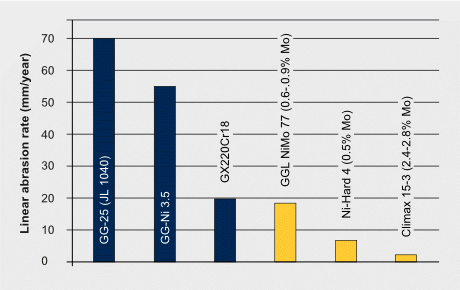White cast irons
Advantages of high chromium and Ni-hard alloys: abrasion resistant, tough, do not require heat treatment, cost-effective
Typical applications: mining crushers, mill liners, slurry pumps, and work roll sleeves
Effects of molybdenum: increases hardenability
Wear-resistant alloyed irons, also known as “white cast irons”, find widespread application in the mining industry for the manufacturing of crushers, mill liners, slurry pumps, and in sleeves for hot mill work rolls. Simple white cast irons are extremely brittle and nearly impossible to machine. Adding chromium in the range of 12-28%, together with nickel and 2-3% molybdenum, produces abrasion-resistant alloys that are tough and castable in large sizes.
These cast irons have acceptable properties as cast, eliminating the need for expensive heat treatment and making them a cost-effective alternative to other grinding materials. Reduced levels of austenite formers, such as nickel and manganese, minimize the retention of low temperature austenite - a potential cause of premature failures. Eutectic carbides in the composition of M7C3 in combination with a martensitic or pearlitic matrix give a full range of material design possibilities. Some of the components are cast with pearlitic matrix to allow machining and are subsequently heat treated to obtain an abrasion-resistant martensitic structure.
Wear performance benchmarking of various cast irons

The principal effect of molybdenum as an alloy addition to white cast iron is increasing the hardenability, or austenite stability, of these alloys. Not all the molybdenum added is effective for hardenability since it also participates in the alloy carbides formed in these irons. Molybdenum can form carbides by itself as Mo2C if present in concentrations over 2%.
At lower concentrations, molybdenum is soluble in M7C3 and MC carbides. Mo2C carbides have a hardness of 1500-1800 HB. Molybdenum is primarily used to stabilize the austenite during cooling after solidification, thus preventing pearlite formation. Molybdenum has little effect on the martensite start (Ms) temperature, compared with other elements that tend to decrease the Ms temperature and over-stabilize the austenite phase.
Molybdenum additions below about 1% are insufficient in suppressing the formation of pearlite in heavy section castings, while amounts greater than 3% offer no additional benefit in that respect. Molybdenum, if alloyed in conjunction with nickel, copper, and manganese, enhances the ability of suppressing pearlite.

